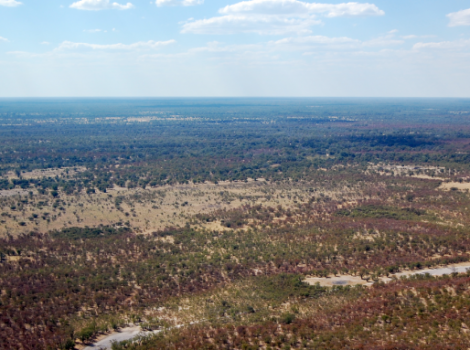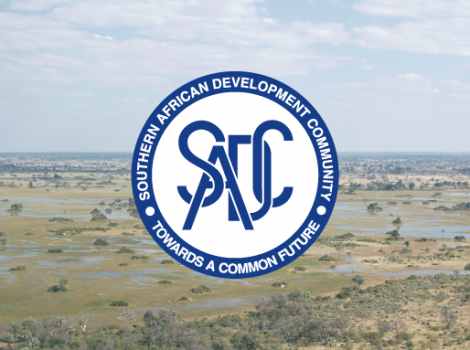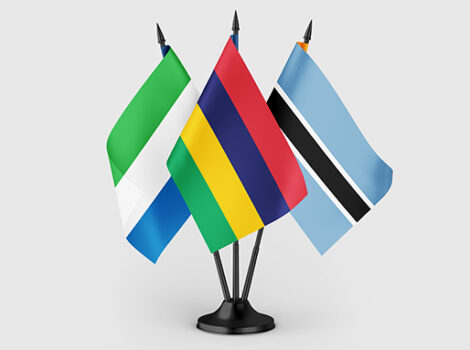
Synopsis
Africa’s Okavango River Basin, which covers 125,000 square miles across Angola, Botswana and Namibia, is home to the largest remaining population of African elephants as well as significant populations of lions, cheetahs, wild dogs and hundreds of species of birds. It’s also a vital source of water for about 1 million people and feeds Botswana’s majestic Okavango Delta, a World Heritage Site that is now threatened by human activity along the rivers that feed it.
In 2015, National Geographic Fellow Dr. Steve Boyes assembled a remarkable team to embark on a four-year project to study this vast and diverse ecosystem to determine how best to protect the delta and its headwaters for generations to come. The first 1,500-mile river expedition of the project brought together local guides and international explorers, storytellers and scientists. The team included 27-year-old marine biologist Adjany Costa, who grew up in the sprawling Angolan capital of Luanda during the country’s brutal civil war, as well as an Okavango native, Tumeletso Setlabosha, nicknamed “Water,” an expert boatsman who spent his entire life on the delta.
Starting in Angola at the source of the Cuito River, one of the three arteries feeding the basin, the explorers travelled by traditional canoe (mokoro), but they soon ran aground when the stream narrowed to a trickle, forcing them to drag their boats across marshland for eight gruelling days. As the river again became navigable, the team’s hopes of documenting a thriving ecosystem were further deterred when they encountered vast tracts of woodland burned by local hunters.
Despite these initial disappointments and setbacks, Boyes and his team continued their journey through the highlands of Angola and soon came across a dizzying array of wildlife. By journey’s end, the scientists collected data from 50,000 locations along the way, chronicling dozens of new scientific discoveries and shedding fresh light on the delicate interconnections that bind humankind with nature.
Directed by National Geographic Society filmmaker Neil Gelinas and featuring stunning wildlife photography and aerial views of rarely seen vistas, National Geographic Documentary Films’ Into the Okavango is a deeply moving chronicle of modern-day explorers forever transformed by the adventure of a lifetime. It is also an attempt to draw the world’s attention not only to the Okavango River Basin, one of the most important areas for biodiversity conservation but to the little-known and vulnerable wilderness area in the Angolan highlands on which it depends.
About the production
A labour of love consuming six years of director Neil Gelinas’ life, Into the Okavango originated in 2011 when the documentary filmmaker visited South Africa in search of potential subjects for a National Geographic program. There, he met ornithologist Steve Boyes, a champion of wetlands biodiversity and an expert on the wildlife of Botswana’s Okavango Delta. What began as a possible short-term television assignment morphed into a full-blown feature documentary after Gelinas became fascinated with Boyes’ intense commitment to protecting this vibrant but fragile oasis in southern Africa.
During a visit to National Geographic’s U.S. headquarters a few months later, Boyes forged a larger partnership with the National Geographic Society, which included the development of a film with Gelinas.
“We decided to make a feature documentary about a multi-country conservation program that merits the world’s attention,” Gelinas recalls.
“From that minute on, we set out to make this film a tool to inform decision-makers about the importance of protecting this precious ecosystem. My job was to capture hearts by showing how humans and wildlife can coexist. Steve’s job was to present the science, which is a lot easier to do when people are emotionally open.”
Next came the hard part – funding the passion project. Initial support from the nonprofit National Geographic Society was supplemented by the Lee and Juliet Folger Fund. Later, in 2016, Boyes debuted a trailer at the National Geographic Explorers Symposium, sparking interest from Clara Wu, a commercial and philanthropic investor who soon provided additional funding as executive producer.
“When I learned about Steve’s mission to protect the Okavango Delta and saw the trailer Neil put together, I knew in an instant that I would support this film,” recalls Wu.
“I had been to the Okavango Delta the summer before and clearly understood why we need to preserve it for future generations. But just as compelling to me was the human aspect of the project; I wanted to tell the story of Steve, Adjany and Water, because I knew their voices would inspire others. Neil’s film tells their story with humility, integrity and beauty.”
Inside the Expedition
Gelinas joined Boyes in launching the National Geographic Okavango Wilderness Project’s first expedition in May 2015. Together with a team of scientists and explorers, including Adjany Costa, a charismatic marine biologist, and indigenous river guide and mokoro “poler” Tumeletso “Water” Setlabosha, they embarked on a 119-day odyssey to better understand and help protect this unique part of the world.
“This film exemplifies what we do best at National Geographic: pairing cutting-edge exploration and science with unparalleled storytelling,” says Gary E. Knell, CEO of
National Geographic Partners.
“By furthering our understanding of the wonders of this remarkable wilderness, we can help generate solutions for a healthier, more sustainable future not only for Angola and the larger region but for our increasingly interconnected world.”
Escorted by the HALO Trust, the world’s largest humanitarian mine-clearing organisation, the team drove through a remote region of Angola littered with undetonated land mines and burned-out tanks left over from the nation’s 27-year civil war. Once they reached the headwaters of the Cuito River, scientists, polers and filmmakers set off in six canoes.
However, after just two days of travel, the stream became impossible to navigate and expedition members, outfitted with harnesses, dragged the fully loaded canoes across the marsh for eight scorching days until becoming waterborne once again. Calloused and exhausted, they soon encountered more disappointment in the form of a desolate, ash-covered zone ravaged by fire instead of an area thriving with plants and wildlife.
Boyes recoiled at the devastation. “Your whole world becomes black,” he says. “Everyone’s covered in ash. People use these highly flammable flood plains and grasses to burn the forest to flush out animals that fall into large pitfall trap lines with sharpened poles and spikes and snares.”
Beyond the Okavango Delta, Boyes led the expedition south, determined to track the outflowing Boteti River to its endpoint in the Kalahari Desert. The contrast between protected wildlife park and unprotected landscape shocked marine biologist Costa.
“At the centre of the delta, you’re bombarded by this amazing wilderness paradise where you feel like Eve,” Costa says.
“Then you leave the protected area, and it’s a slap in the face: ‘Wake up, the paradise is gone.’
There are a lot of donkeys, goats and cattle, and the water’s dirty so you can’t drink it anymore. As soon as you exit the park, you’re reminded of how special Okavango is. It made all of us want to extend that quality of wildlife to the rest of the basin.”
After 1,500 miles, the explorers completed their mission in a sweltering stretch of mud flats. “We were absolutely broken,” recalls Boyes. “Your body knows the trip is about to end. It was incredibly emotional.”
119 Days of Science
While the expedition proved arduous, Boyes and his fellow scientists gathered data at every point along the way.
“On the river, we’d be counting birds and elephants all day long,” Boyes says.
“When we stopped for the day, we did our land-based surveys, we took soil samples, and we caught fish in a variety of nets. We made real-time recordings of bats and frogs, and we looked at species diversity. We looked at seven different parameters of water quality. We studied underwater vegetation and water lilies. It took a few weeks to get into our rhythm, but then it became like ‘Groundhog Day.’ We did the exact same thing at exactly the same time every single day for the next 100 days.”
Among the team’s discoveries: a huge tract of spongy land in Angola capable of absorbing 25 times its dry weight in water.
“These ancient source lakes are surrounded by peat deposits that weren’t supposed to be there, especially on that scale,” Boyes says.
“People had made assumptions about how water functions in this vast landscape, which had been completely misunderstood. A lot of the modelling around how we can revive these river systems had been incorrect until we went on this expedition.”
Data collection extended to tracking Boyes’ health with digital devices worn throughout the trek.
“My biometric watch was linked into our research system,” Boyes says.
“On the second day of pulling the canoes, my average heart rate over eight hours was 135 beats per minute. The average recovery period according to my weight and height and profile was supposed to be 143 hours. Six days! But we had to do it all over again the next day.”
For Costa, the expedition led to a number of revelations.
“We discovered four potentially new species, which was extremely exciting,” Costa says.
“We also found at least two kinds of fish that nobody knew existed in the Okavango River Basin. Usually, you work within well-known areas, whereas this was about being in a truly untouched place. I’d never had this experience of discovering a possible new species, so science- wise, this was a unique experience.”
A Natural Wonder Worth Protecting
Through its riveting blend of vivid personalities and gorgeous nature footage, Into the Okavango tells the story of a region ripe with potential.
“We’d like the Okavango to become a household name,” says Gelinas. “We’d like the world to recognise how special this place is, and we want people to care about preserving the Okavango. I’m not going to make any money from this project. The film was made with contributions from people who truly care about the Okavango. They don’t want anything in return except the conservation of this land.”
Costa believes Into the Okavango will inspire fresh thinking about this previously troubled corner of the world.
“There used to be this big taboo about the part of Angola you see in this movie because the civil war was fought there,” Costa says.
“Everyone saw it as the last place on Earth that one should go because it’s so dangerous — nothing good could ever happen there. But this expedition has opened up a curtain and shown the rest of my country that opportunity can come from this area and help renew Angola’s reputation. It’s our future.”
Into the Okavango invites moviegoers to marvel at the wildlife and waterways that continue to fascinate Boyes.
“People ask me, ‘Does it feel strange to be back home, going about my regular routine?’ and I answer, ‘I’m still there,’” Boyes says.
“I’m talking to you, but I’m still there.’ You become that river. You absolutely become obsessed with every ripple. We traversed this massive landscape twice the size of England, and to have that vast wilderness wrap around you, it changes your life completely.”
Boyes hopes Into the Okavango generates support for the project’s ongoing campaign to expand conservation efforts in Africa by helping to protect a continuous landscape encompassing portions of Angola, Namibia and Botswana.
“This is one of the greatest conservation opportunities left and a rare chance to intervene before reaching the crisis point,” Boyes says.
“We certainly didn’t launch with the objective of creating one of the largest protected areas in the world. But thanks in part to this film, that opportunity is starting to become very real.”
The screenings will take place at 17:30 on the following dates:
- Friday 7 June 2019
- Friday 21 June 2019
- Friday 5 July 2019
Tickets for the screenings will be available through Webtickets. By purchasing a ticket, cinema-goers will be making a donation to the Botswana Wild Bird Trust in order to enable it to cover the cost of each cinema screening.
About The Botswana Wild Bird Trust
The Botswana Wild Bird Trust, a subsidiary of the Wild Bird Trust in South Africa, administers and executes the expeditions and exploration of the Okavango River Basin from its base in Maun, Botswana as part of the National Geographic Okavango Wilderness Project (NGOWP). The NGOWP is a collaboration between the National Geographic Society and the Wild Bird Trust and has been exploring the entire Okavango River Basin from its sources high in the Angolan highlands to the sands of the Makgadikgadi Pans in Botswana since 2015.
Source: natgeotvpressroom.com, wildbirdtrust.com



